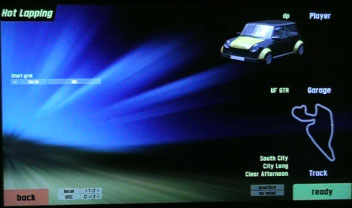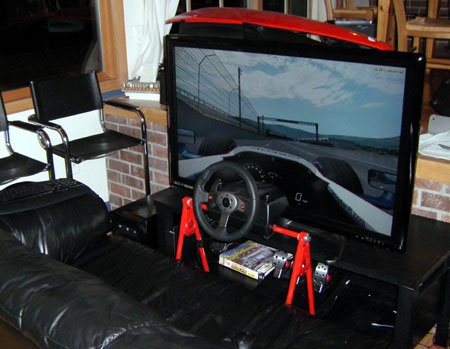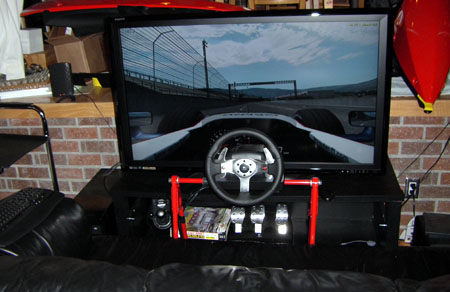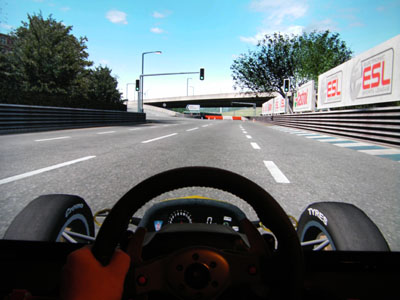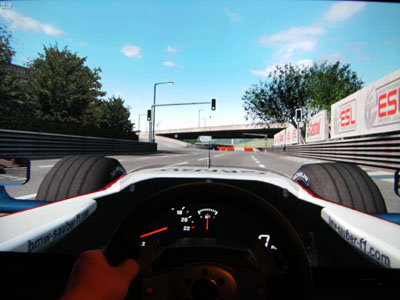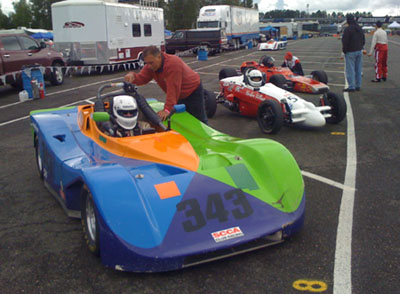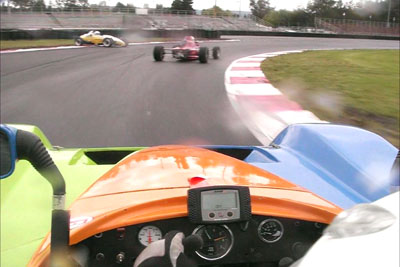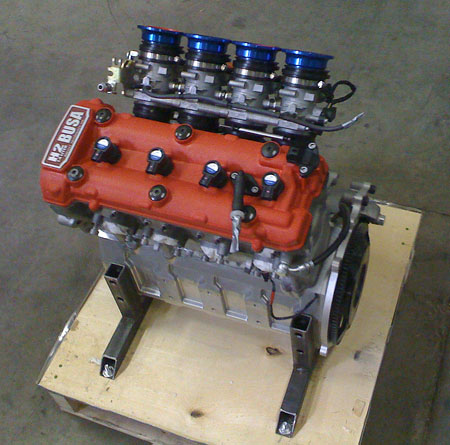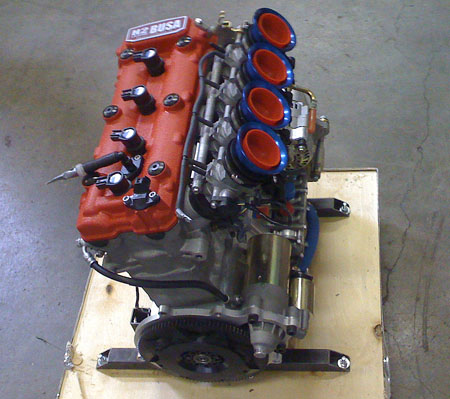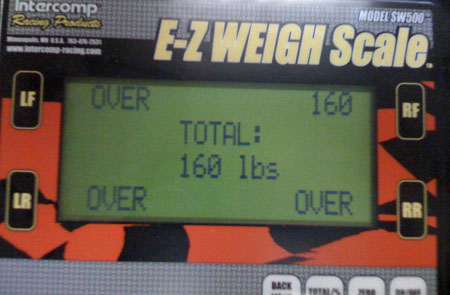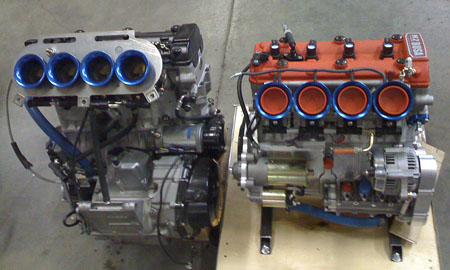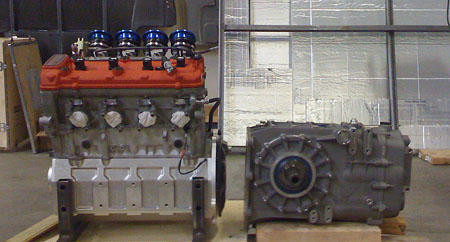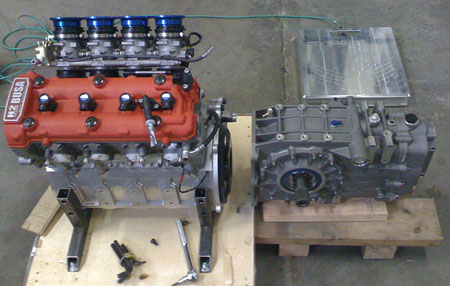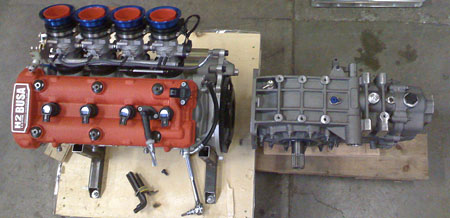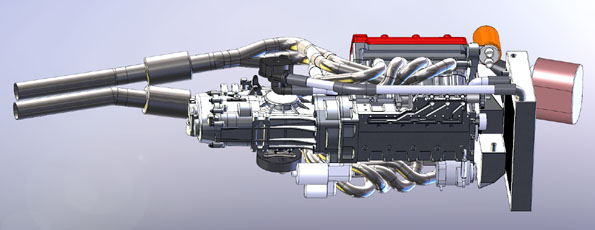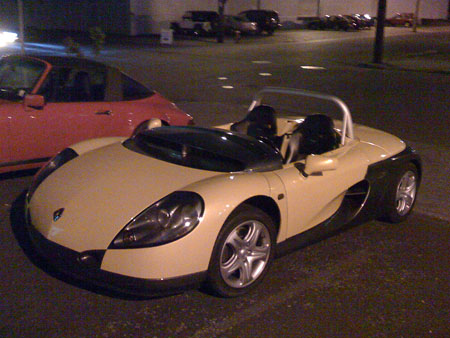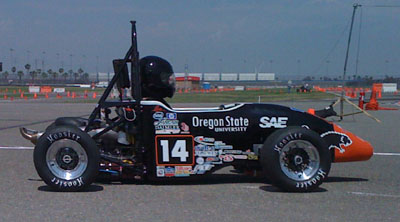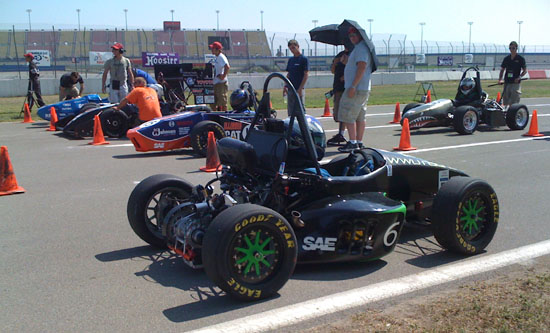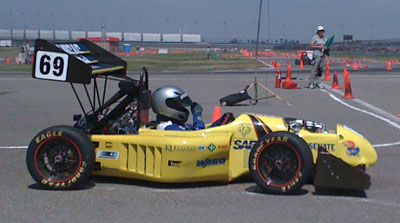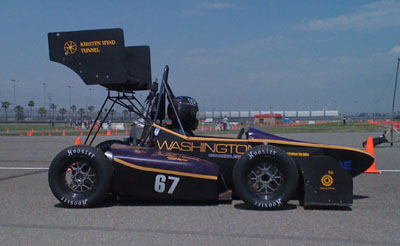|
03/16/07 (UPDATED 10/24/07 see below) As I've mentioned elsewhere, I was recently made aware of an excellent driving sim/online game called LiveForSpeed (you can download it here - demo mode is free). It took some fiddling with setup - had to download an updated driver for my video card and then I realized that I need steering wheel and pedals to do this thing any justice so I got those and finally set it all up downstairs where the big 'monitor' is (it's not a TV as such since it's hooked up to a computer for playing DVDs and there is no cable or antenna). Anyway, the gear looks like this:
My first attempts to drive the thing were dismal. It was a big revelation just how much I rely on seat-of-pants feedback for car control. I use visual cues to plan the trajectory and start the turn, but once in it the feel and the sound is what lets me keep the car on the line. With the g loads missing it felt 'empty'. But, like when a person loses one of their senses, eventually they learn to adapt and rely more keenly on the rest. This is essentially what happens with the sim. I hadn't had much time to play with it recently but today I took a couple hours and got relatively comfortable with it. One of the fun tracks is 'South City', a street circuit that is quite challenging. I chose a 'UF GTR' to drive - basically a classic Mini with tons of power and suspension. After a while I realized the car can be pitched and throttle-steered just like my RealLife MINI so I started enjoying the game more and more. In fact it was so much fun that I decided to set up my video camera on a tripod and tape some of it. Click on the picture below for a video of my best lap after about an hour of practice (the file is 18M in size so it may take a while to download). One big advantage of the sim is that you can push as hard as you please with no fear of consequences, so the learning techinque is very differnt from RL. Just push until you crash, then back off a bit and try again. This is pretty damned cool :) But now - back to reality, since a lot of work remains and the track season is officially here.... 10/24/07 Now that the rains are upon us I've been playing with my LFS setup some more. One thing that has been bothering me is the 'remoteness' of the experience. So I started tweaking the view parameters, one of which is view angle. If I set it to something relatively high like 90 degrees, I can actually see into corners but the sides of the display are distorted. At 60 degrees it looks more natural but it's like driving with blinders on. Then it occurred to me to sit down and figure out where my eyes should be for proper perspective. My 46" diagonal LCD is about 40" wide. This means that for a 90 degree view my eyes have to be just 20" from the screen! Ah, now it makes sense. So I started going through the house trying to see what I can rig up for seat/pedal/wheel mounts in proper places. I tried many iterations and measured a lot. I went from being 80" from the screen to 60" to 40" and finally to 30". The new setup looks like this after modifying some furniture and making good use of a few spare dp1 suspension parts:
WOW, what a difference in the experience! It now really feels like driving. I can turn my head and look through corners. I can see gauges through the steering wheel. Below are actual eye-level pictures of some of the standard LFS cars. The screen is so high resolution (1920x1080) that even sitting this close I still don't notice individual pixels. Technolgy rocks.
People have asked me if I ever race online. So far I haven't. Just like in real life I seem to prefer hot-lapping and test-and-tune sessions to actual racing. That may change at some point but for now I'm happy just playing around and I'm learning a LOT about how I drive, the effects of car setups and many other things. This is fun :) 06/08/08 With everything that's going on a race license is becoming necessary so after taking the Cascade school (see Mini entry for 06/06/08), it's time for my first novice race. Larry has kindly agreed to lend me his Spec Racer Ford (SRF). The car weighs a bit over 1,600 lbs and has around 110 hp from its 1.9L Ford engine so it's no rocket ship (a stock Mini S accelerates better), but the handling is nice. It's a good car for developing driver skill. Motorsports Engineering, the guys who normally take care of Larry's cars, did the prep and brought the car out to the track. It's great to have everything taken care of especially at the first event like this, but of course there is a cost involved so it's a tradeoff.
Even though the car is closed wheel it is classed as 'Open Wheel Novice' and I was put in Group 6 along with a bunch of formula cars and much faster Sports Racers. For Closed Wheel Novice there are two practice sessions and a race on Saturday and no events Sunday. Group 6 has two practices Saturday and then Qualifying and the race itself is on Sunday so I'll have to be here two days instead of the planned one, meaning I have to pay for the car to be here another day. Ah, what the heck, let's just go for it! Saturday is cold and overcast. The clouds occasionally dump drizzle and rain on the track just to keep it interesting. My first practice session starts out on the dry surface but within five minutes it's raining and I see three cars spin on just that one lap. It looks like this on video: (a 20Mb file) - watch for a FV going off the track in front of me in the first few seconds of the clip! Between the weather and this being my first time in the (borrowed) car, my lap times are pretty slow. I still pass many of the people in the session but that's because the fast guys just sat it out, nothing to gain by practicing in this stuff. I start out cautiously at 1:40's and incrementally work my way down from there. Best time is a high 1:35 which is way off the 1:28-ish track record for SRF. The session is a great learning experience though - I got to drive in changing conditions including rain, did some passing, was passed a few times, dodged a number of spinning cars and managed to stay on the track myself. A successfull mission. Second practice sesssion is more of the same - cold and wet. A lot fewer spins and a lot more people pass me. Best lap time is only half a second faster, in the low 1:35 range, but I'm getting more used to the car. I call Larry and ask him to send his GPS data so I can compare and figure out what I need to work on tomorrow. While I'm doing all this, M volunteered to work the turn 11 corner station and she seems to be enjoying it - despite the rain and cold. According to other corner workers she's been making wise-ass remarks every time I'd go by, like 'the gas pedal is on the right'. Merciless, this one is. She does make friends fast and ended up driving the Viper pace car for a couple laps during lunch. On race day the weather is much better. Clouds clear up and temps rise to high 60's which is just about perfect. I'm a bit apprehensive at qualifying, with all the 21 cars on the track including some that are 10-15 seconds faster than me. After looking at the data (see below) it is clear that I need to work on corner speed and that will be my main focus. So I just resolve to stick to the plan and watch my mirrors. M is working the pit exit station today and comes over on the grid to wish me luck. It's great to have her here. Hopefully soon she'll be racing (and I will likely work since a certain amount of time at corner stations and other duties is part of the requirements for upgrading a Novice license to Area license). Qualifying goes smoothly, I stay out of the way of fast guys and pass a few of the slower cars. Focusing on corner speed pays off and I qualify 13th overall with a 1:32.373. Fastest car is a Formula Continental at 1:19.283 and slowest is Formula Vee at 1:47.611 which gives you an idea of the speed differentials in the group. In the dry I'm able to get some heat in the tires and start approaching the edges of traction in a couple corners, the left-hand, off-camber turn 6 in particular. Three hours later - the main event. I find that I'm not particularly nervous sitting on the grid. Just focusing on what I'm going to do and how. We did a practice race start in the school Friday so it's not a big deal. One of the cars ahead of me seems to have some issues with his engine so I jump a few spots forward on the start but that quickly goes away in the next few laps as faster cars repass me. My main goal is to finish the race without incident and secondary goal is to work on corner speeds so I pay close attention to the mirrors and let the fast guys go by when they lap the field. There is a vintage Formula car that seems to be running lap times similar to mine so I chase him for a few laps. I can tell that I'm entering turn 4 way too slow still and the data backs it up. I feel like I'm making good progress in turn 10 but there's still much more to be gained there. In 6 I'm at the edge so that's a good place to work on car control at the limit. Guess it'll take a while longer to recalibrate myself for the faster cornering that this car is capable of. Below is a video of some race and qualifying highlights (55M file): Being in a race is subtly different from a trackday session. It's much more 'businesslike', with more of a sense of being on a mission. It is also more tiring mentally and physically. Still, the race goes without incident as intended, and I get a number of positive comments from other drivers afterwards. I'm in the Open Wheel Novice class and place last, 6/6. My best race lap is 1:32.025 which is 1/3 second faster than my qualifying time. In driving the car two 25-minute sessions today I dropped 3.5 seconds off my best lap time yesterday and I'm now 3.5 sec off the track record for the SRF class. Of course the remaining seconds will be a lot harder to eliminate :) Now on to the data. The picture below shows three traces. Red is my best practice lap from Saturday, black is my best race lap and orange is one of Larry's better laps in practice at 1:29.08 - exactly 3 seconds faster than mine. Chris from Motorsports Engineering tells me that the tires I was on are not the best and may be costing me a second (would be silly to use up best tires for a novice race anyway) but regardless of any such excuses it is very clear I have a lot to work on. The traces also show that I did make significant progress from one day to the next, exactly in areas I was working on. So that much is encouraging.
The first thing is the entry to the chicane. Larry carries a whopping 10 mph more into the corner, at 58 mph vs my 48 and that alone costs me 0.7 sec at the chicane exit. The next and probably greatest difference is entrance to 4. Larry goes in at nearly 76 mph whereas I tiptoe in at 65, on both days. On my best lap, the time deficit is at 1.3 sec vs Larry's by the exit of turn 4 and grows to 1.5 sec at the entrance to 6. Through 6 and 7 it felt like I was using the car pretty well and the data bears that out, with speed traces matched much closer to Larry's through that section. I still lose some time and exit turn 7 nearly 2.0 sec behind. The back straight is nearly a wash (Larry seems to shift at slightly higher speed/rpm but only gains 0.1 sec on me to the entrance of 10. Turn 10 is another place where much more speed can be had. You can see my progress from one day to the next, where I was only doing 75 in the turn on Saturday (which is 6 mph slower than what I do in the Mini on street tires!) to 85 in the race. Larry goes through at 90 and actually accelerates for 11 where I coast. So, by the exit of 12, a 3.0 second difference and it is quite clear what I need to do to close the gap. Datalogging is wonderful for this - there is no way I'd be able to have such a clear picture of what needs to be done without it. Overall, my first race has been a great experience. There are some positive things about racing and some aspects which are less attractive than trackdays. It is definitely expensive (the weekend cost me about 5x what a trackday would, for same or lesser amount of tracktime, and that's with the car itself being free). There is a lot of waiting around and logistics/prep/etc. especially given the amount of tracktime involved. On the plus side, the experience of being in an actual race, and the camaraderie at the track is more intense and satisfying. At this point I'm still undecided if I'm going to pursue racing long-term but in the near term I definitely want to follow through with getting the license and most likely upgrading to International/Senior level. I think having the credentials will be a good thing when it comes time to run my various toys at venues far and wide, and I'm certain I will learn a lot and improve as a driver in the process. Already have, in fact. 05/04/09 For a long time now I've been convinced that the proper way to put a Hayabusa in a car is to remove the motorcycle gearbox and clutch, convenient as they are, and do a proper billet crankcase with drysump and a flywheel. A setup like that would mate to a more car-appropriate gearbox. When I mentioned the idea to John Hartley a couple years back he was receptive but focused on getting the V8 done. About six months ago he was finally ready to tackle this project - the V8, as awesome as it is, is really overkill for cars like Caterhams and their ilk. Both in cost and in power, you just can't put it down in a 2WD car that light. While on the surface just stuffing a bike motor into a car, transmission and all, seems attractive, the reality quickly sinks in - the need for reversing box, dealing with drive shaft offset, inappropriate gear ratios, touchy clutch, the engine being too tall, needing a drysump, etc. So what starts out as a 190 lb, $2500 engine install quickly grows in weight, price and headache. All of it can be surmounted of course (witness the Westie in my past) but there's a better way. Enter the Hartley H2:
This particular engine already has a home - as part of a high-performance hybrid powerplant in an application that will be announced in due time. This H2 is relatively 'basic' - a 1.4L unit with stock Suzuki cams, 84mm pistons and a stock crank modified to accept a flywheel. Versions up to 1.6L (with a custom billet crank and rods) will be available. The base 1.4L dynos at 193 hp. A full-blown 1.6L with cams, CNC head porting and custom ECU should easily top 250 hp and I'm hoping for 275. That's before adding a turbo :) All the proven Hayabusa mods are easily bolted on of course. The engine fully dressed (intake, with starter, alternator, drysump pump and flywheel) weighs 160 lbs. That's roughly half of an equivalent high-performance car motor of same power, with same accessories attached. And it's much more compact, too.
Compared to a stock Hayabusa with the bike gearbox, the H2 is about 3" lower. In many cases that makes the difference between fitting easily and having to add scoops or bulges to bodywork.
There are quite a few gearboxes that could work with this motor. My current favorite is the Hewland JFR - it's a 5-speed (or 6-speed) sequential with a reverse and a wide range of gearing choices. The box itself weighs 70 lbs so the combined package weighs 230 lbs. When compared to a stock 'busa (190 lbs) + reversing box (15 lbs) + differential (40 lbs+) it's actually a fair bit lighter for equivalent functionality and MUCH cleaner and easier to package into a chassis.
Of course there is a cost involved and it's not for everyone. Being essentially half of H1 V8 it's no surprise that a complete H2 is about half the cost of that motor. Hartley is actually offering comprehensive kits (you supply your own 'busa motor and labor) starting at $8,500 for base configuration and $12,500 for 1.6L stroker kit. Assembled ready-to-run, dyno'd engines of approximately 195hp output will start at around $13,000 in base form. An all-out fully built 1.6L stroker with cams and pushing over 250 hp will approach $20K. Considering what one can spend trying to get 140 hp out of a classic Mini motor, as an example, this is actually quite a bargain. Ligher, smaller and more reliable too. I have a vision of a 275hp 1.6L in my old Elise 190, with a sequential box - which means that odds are that sooner or later it'll probably happen :). Palatov Motorsport is a dealer for Hartley engines and we will be offering kit assembly, installation design (exhaust, mounts, bellhousings, etc), fabrication and complete installs. Contact us for details. As a side note and an example of the kinds of installations we'll be doing, after some discussions with John I had to increase the diameter of the headers on the dp1. Given the tight space constraints this was no trivial task but I got it done. The complete package with full headers (4-2-1 with equal length 24" primaries and 9" secondaries) is only as wide as the engine itself and the headers clear the drysump pump, the starter and the alternator. We'll start fabrication of the exhausts shortly. The bellhousing I designed to mate the V8 to the JFR box is already being made.
05/15/09 A Pro Rally event is in town, running a few stages at PIR before heading out to the woods. Larry decided to bring some of his Group B cars out for display and recruited us to assist with transporting the cars to the track and back. This involved Tristan and I driving two of the cars and M being the shuttle driver in the Rux. Tough work :) Granted the drives were brief and on normal streets at reasonable speeds (except for a burst or two and a parking lot frolic) but they were enough to at least get a glimpse of what these beasts are about. I drove the RS200 on the way to the track. On the street the car is best described as difficult - the clutch has the odd characteristic of engaging at the top of travel but disengaging a good ways down, or so it seems. Gearbox is very reluctant and requires double-clutching to get most gears when moving at street pace. Getting it going off the line without stalling is a task for which the Atom has somewhat prepared me but still not enough to avoid killing the engine a couple of times anyway. Once underway the nature of the car becomes apparent. The way the suspension and engine respond tells quite clearly of how much it would excel in its natural element - blasting all-out on remote gravel roads. The ride is very controlled and laughs at road imperfections. Steering response is direct but insulated, not numb but rather reassuring that if you went blasting over deep ruts at 100 mph it wouldn't rip your hands out of their sockets. It is also very apparent that it would take a driver of extraordinary skill to extract the most from this car (certainly more skill than I have). I did open it up on a couple occasions and the rush is satisfying but not overwhelming (the Atom has spoiled me here more than a bit). The overall experience with the RS on the street is at once frustrating and intimidating - this is clearly more car than I know how to use and its preferred environment is something that is unfamiliar and quite daunting to me. Street driving isn't it.
On the way back I got to drive the Lancia S4 Integrale. It is a vey interesting machine from a technical standpoint, having both a supercharger and a turbo. It is also very Italian, in the best way. The sound is incredible - a raw shriek that resonates in every panel of the interior. It gets hot inside very quickly. The engine delivers a healthy push all the way to its 7K redline with the turbo seamlessly taking over just when you'd think the supercharger would start trailing off. The suspension is quite a bit more lively and less settled than the Ford and the overall feel is that this car would ultimately be a little less capable than the RS200. However on the street it is far more entertaining. It is easier to drive with the clutch and gearbox being fairly straightforward. Oh and did I mention the sound?! :) Before putting it back in its stable I just couldn't resist some fun in a nearby parking lot. The lot (where M learned to ride the 748) is ideal for this, with some loose gravel, uneven surface and wide open spaces where I could push this rare beast a bit without fear of hitting anything. The turn-in is controlled with virtually no understeer and the car responds to throttle steering quite well. Power out of turns is linear and satisfying. This thing is FUN! :) If in some unreal universe I were forced to choose between the S4 and the RS200 as my primary mode of transport, this would be the one I'd choose without hesitation. On a rally stage the Ford is almost certainly the better performer of the two, in the right hands, but I don't have what it takes to use it and I'm not sure if it's something I could learn (would be cool to try though but that's another story altogether). The Lancia's awesomeness is easier sampled and for that it is my favorite here.
To top the day off I also got to drive a few blocks in the Renault Spyder. Conceived about the same time as the Elise and generally similar in concept (a minimalist aluminum-framed roadster), the execution is quite different. It doesn't have the tactile delicacy of the Elise, nor is it as refined in ride and handling. But the 'virtual windscreen' is brilliant and quite effective, deflecting the wind blast to just above the top of my forehead and making the drive comfortable even without eye protection. Very different from the Atom, for example.
The power is quite a ways down from the rally cars (no surprise) and also is less responsive than what I remember the Elise to be. When exercised in the same bumpy parking lot as the Lancia, the Renault shows decent manners but its weight and relatively soft suspension do make themselves known. Definitely a unique experience and a great wrap-up to the day. These brief samples were quite fun but I'm hoping to be able to drive these (and some other) cars a bit more extensively in the future and see if the perception will change with a bit of familiarity. 06/17-06/20/09 This year I had the privilege of being one of the design judges at Formula SAE West. This was particularly interesting to me since I have gone through much of the same process that the teams had to undertake. The preliminary and semi-final design judging took place prior to the dynamic events so in a very real way the teams' and their cars' performance on the track was a reality check of our judging. Gratifyingly, the teams we picked for the finals - Oregon State and RIT - both did extremely well with RIT taking first in autcross and OSU taking first in fuel economy and combined economy/endurance. The OSU car is impressively light at a mere 307 lbs.
I spent most of the time Thursday and Saturday judging and didn't get a chance to take pictures - the only snapshots I have are from the autocross event on Friday.
There were some fairly innovative mechanical solutions and a number of the cars were really well done. The teams who chose to implement aero generally went with triple-element wings...
With the exception of RIT who had no wings but a really well thought-out undertray of which I don't have a picture. RIT was also the fastest in autocross - coincidence? Hard to say. There are lots of factors that go into a fast A/X time, driver being not the least of them. At the very least I was impressed with their analysis and design process. Despite the cosmetic variety and a vast array of different subsystem designs, all the cars generally had a fairly conventional RWD mid-engine layout with a motorcycle engine of some sort sitting directly behind the driver. I was hoping to see some more creative approaches but I guess I'm biased that way :) Going into the event I was questioning the continued need for intake restrictors - with a maximum attainable power of around 80 hp the more powerful cars seem to be traction-limited anyway. After some discussions with the powertrain judges I now understand the reasons. First, it prevents teams from just plunking a stock engine in the chassis and forces them do the research and the analysis, development and fabrication of quite a number of powertrain components. Turns out it is possible to achieve choked flow (sonic velocity) in the restrictor, which was a surprise to me, and a pretty thorough understanding of gas flow is necessary to make it and the rest of the powertrain work well. Interesting. Another surprise was that despite a very high overall level of technical knowledge demonstrated by the two finalist teams, neither of the frame designers had an understanding of how the front suspension is actually loaded under braking and that the brake torque is additive to longitudinal force on the lower arm. In the case of OSU this cost them a broken suspension in the braking event and was a very significant factor in them coming in second in design to RIT. They also ended up second overall with RIT taking the win and Kansas (another very well done car, the yellow one in the pictures above) coming in third. Overal quite an educational experience for me. I couldn't help but think about how my own designs would fare if judged by the same criteria and I have to admit that I might have lost a few points here and there... Something to consider as I move forward. Would have done OK on innovation, so at least there's that :) |

